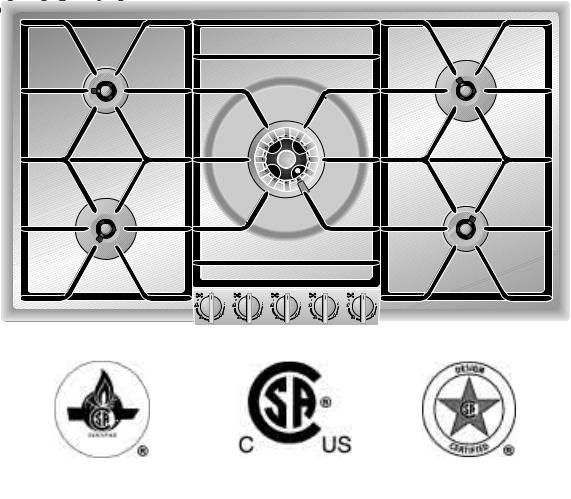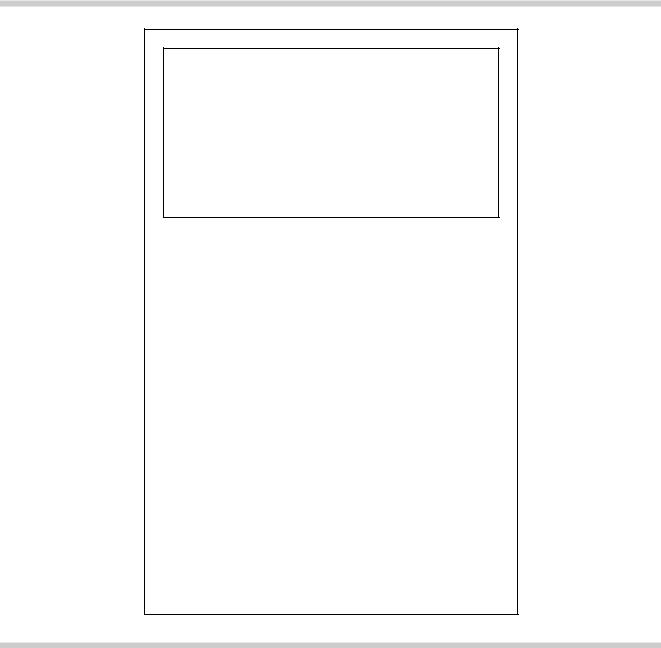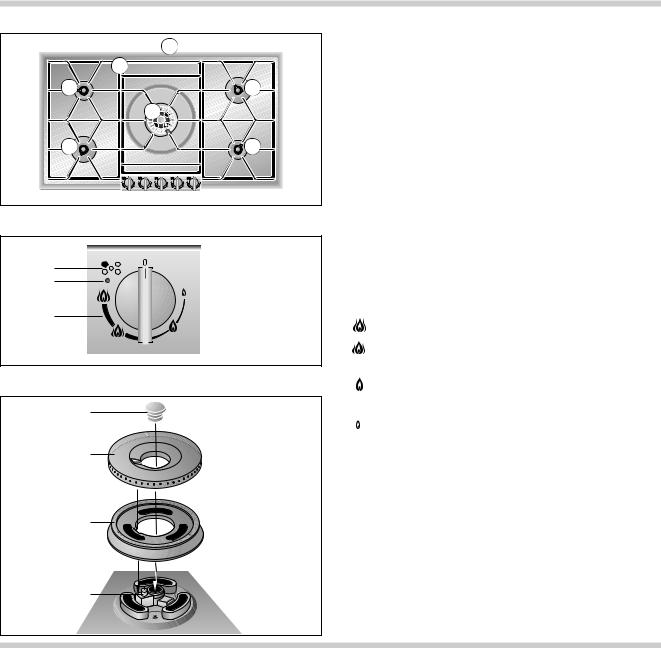Gaggenau KG 291 CA User Manual

Operation, Maintenance and Installation Manual
KG 291 CA
Gas Cooktop
KG 291 CA
|
FOR YOUR SAFETY |
Page 2 |
|||
|
1. |
Important Information for Installation and Use Page 3 |
|
||
|
2. |
General Safety Instructions |
Page 4-5 |
|
|
|
3. |
Important Notes |
Page 6-7 |
|
|
|
|
For Your Safety |
Page 6 |
||
|
|
Operating for the First Time |
Page 6 |
||
|
|
To Use |
Page 7 |
|
|
4. |
Features |
Page 8 |
|||
|
|
Features of the Appliance |
Page 8 |
||
|
|
Control Knob |
Page 8 |
||
|
|
Burner Parts |
Page 8 |
|
|
|
5. |
Operating Principle |
Page 9 |
|
|
|
6. |
Operation |
Page 10-11 |
||
|
7. |
Burner Settings Chart |
Page 12 |
|
|
|
8. |
Cookware Recommendations |
Page 13 |
||
|
9. |
Wok Cookware Recommendations |
Page 14 |
|
|
|
10. |
Cleaning and Care |
Page 15-17 |
|
|
|
|
|
|
|
|
|
11. |
Maintenance |
Page 18 |
||
|
12. |
Trouble Shooting |
Page 19 |
|
|
|
13. |
Technical Data/Settings Table |
Page 20-21 |
|
|
|
14. |
Installation Instructions |
Page 22-29 |
|
|
|
|
Important Notes |
Page 22 |
||
|
|
Cabinet Requirements |
Page 23 |
||
|
|
Electrical Connection |
Page 24 |
||
|
|
Gas Connection |
Page 25 |
||
|
|
Nozzle Replacement |
Page 26-28 |
||
|
|
Installing the Appliance |
Page 29 |
||
|
|
|
|
|
|
1

FOR YOUR SAFETY
WARNING: If the information in this manual is not followed exactly, a fire or explosion may result causing property damage, personal injury or death.
Do not store or use gasoline or other flammable vapors and liquids in the vicinity of this or any other appliance.
WHAT TO DO IF YOU SMELL GAS:
–Do not try to light any appliance.
–Do not touch any electrical switch; do not use any phone in your building.
–Immediately call your gas supplier from a neighbor’s phone. Follow the gas supplier’s instructions.
–If you cannot reach your gas supplier, call the fire department.
Installation and service must be performed by a qualified installer, service agency or the gas supplier.
2

1. Important Information for Installation and Use
1.Do not allow the flame to extend beyond the edge of the cooking utensil. This instruction is based on safety considerations.
2.Do not forget that the unit becomes hot when in use. Common sense is important. Just because the flame is out, it does not mean parts still cannot be hot.
3.This appliance shall not be used for space heating. This instruction is based on safety considerations.
4.Be sure to disconnect the electrical supply before disassembly of the appliance.
5.Keep the appliance area clear and free from combustible materials, gasoline and other flammable vapors and liquids.
6.Do not obstruct the flow of combustion and ventilation air.
7.Cabinets installed above the gas cooktop must have a minimum distance of 762 mm (30 ´).
8.The gas pressure regulator supplied with the appliance must be installed in line with the gas pipe.
9.The appliance and its individual shutoff valve must be disconnected from the gas supply piping system during any pressure testing of the system at test pressures in excess of 3.5 kPa (1/2 psig). The appliance must be isolated from the gas supply piping system by closing its individual manual shutoff valve during any pressure testing of the gas supply piping system at test pressures equal to or less than 3.5 kPa (1/2 psig).
10.Important:
When using a very large pot, keep a distance of at least 50 mm (2") to avoid damaging any parts in counter top wood, plastic or other non-heat- resistant materials. Never leave oil or hot fat
unattended.
Note: To avoid jeopardising the electrical safety of the appliance, it is forbidden to use high-pressure or steam jet cleaning devices.
Note: The name plate is attached to the bottom of the unit and to the inside of the housing.
Only for Installation in USA:
This installation must conform with local codes or, in absence of local codes, with the National Fuel Gas Code, ANSI Z 223.1 Current Issue.
The installer must leave these instructions with the appliance, and the consumer should keep them for future reference. If an external electrical source is utilized, the appliance must be electrically grounded in accordance with local codes, with the National Electrical Code ANSI/NFPA 70 Current Issue.
For Massachusetts Installations:
1.Installation must be performed by a qualified or licensed contractor, plumber or gas fitter qualified or licensed by the state, province or region where this appliance is being installed.
2.Shut-off valve must be a “T" handle gas cock.
3.Flexible gas connector must not be longer than 36 inches.
Only for Installation in Canada:
In Canada, installation must be in accordance with the CAN 1-B149.1 and .2 – Installation Codes for Gas Burning Appliances and/or local codes. The installer must leave these Instructions with the appliance and the Consumer should retain them for future reference.
This appliance when installed, must be electrically grounded in accordance with local codes or, in the absence of local codes, with the current CSA Standard C 22.1-Canadian Electrical Code, Part I.
For mobile Housing and Recreational Vehicle installation must conform with the following:
CAN/CSA Z240 MH
CAN/CSA Z240 RV
Installation Requirement For Gas Burning Appliances And Equipment In Mobile Homes CSA Standard C 22:1 - Canadian Electrical Code Part 1 and /or local Codes.
3

2. General Safety Instructions
Read all instructions in this Operation and Maintenance Manual carefully before using your new GAGGENAU Cooktop. As the user, you are responsible for maintenance and proper use in the household.
WARNING: These precautions will reduce the risk of burns, electric shock, fire, and injury to persons. Use extreme care when using this cooktop as this appliance provides intense heat and can increase the accident potential.
When using kitchen appliances, these basic safety precautions must be followed:
•Insure proper installation and servicing.
Follow the installation instructions provided with this product. Have the cooktop installed and grounded by a qualified technician. Do not operate the appliance if it is damaged.
•Have the installer show you where the gas supply shut-off valve is located so that you know how and where to turn off the gas to the cooktop.
•If you smell gas, follow the instructions on page 2. If the connections are not perfectly tight, you can have a small leak and therefore a faint gas smell. Finding a gas leak must be done by a qualified service technician.
•Do not repair or replace any part of the appliance unless specifically recommended in this manual. All other servicing should be referred to a qualified technician. Disconnect the appliance from the power supply at the fuse point and the gas supply during every maintenance operation.
•Children should not be left alone or unattended in an area where appliances are in use. They should never be allowed to sit or stand on any part of the appliance.
•Do not store items of interest to children above the cooktop or at the back of it. If children should climb onto the appliance to reach these items, they could be seriously injured.
•Never use any part of the cooktop for storage. Flammable materials can catch fire and plastic items may melt or ignite.
•When connecting electrical appliances near the Cooktop, make sure that connecting cables do not come into contact with hot cooking surfaces!
•If the cooktop is near a window, be certain the curtains do not blow over or near the Cooktop burners; they could catch on fire.
•DO NOT USE WATER ON GREASE FIRES.
Turn appliance off and smother fire with baking soda or use a dry chemical or foam-type extinguisher.
•Never let clothing, pot holders, or other flammable materials come in contact with or close to any burner or burner grate until it has cooled. Fabric may ignite and result in personal injury.
•Use only dry pot holders. Moist or damp pot holders on hot surfaces may cause burns from steam. Do not use a towel or other bulky cloth in place of pot holders. Do not let pot holders touch hot burner grates.
•For personal safety, wear proper apparel.
Loose fitting garments or hanging sleeves should never be worn while using this appliance. Some synthetic fabrics are highly flammable and should not be worn while cooking.
•The appliance is designed for cooking food.
Based on safety considerations, never use the Cooktop to warm or heat a room. Such use can damage the Cooktop.
•When using the Cooktop: DO NOT TOUCH THE BURNER GRATES OR THE IMMEDIATE SURROUNDING AREAS. They become hot enough to cause burns.
4

•Never leave the cooktop unattended.
Boil-overs cause smoking and greasy spills that may ignite.
•Only certain types of glass, heatproof glassceramic, ceramic, earthenware or other glazed utensils are suitable for cooktop use.
This type of utensil may break with sudden temperature changes. Use only on low or medium heat settings according to the utensil manufacturer’s directions.
•Do not heat unopened food containers; a buildup of pressure may cause the container to burst.
•During cooking, set the burner control so that the flame heats only the bottom of the pan and does not extend beyond the bottom of the pan.
•Use caution to insure that drafts like those from forced air vents or fans do not blow flammable material toward the flames or push the flames so that they extend beyond the edges of the pot.
•Always use utensils that have flat bottoms, large enough to cover the burner. The use of undersized utensils can expose a portion of the flame and may result in ignition of clothing.
•To minimize burns, ignition of flammable materials and unintentional spills, position handles of utensils inward so they do not extend over adjacent work areas, cooking areas or the edge of the cooktop.
•Hold the handle of the pan to prevent movement of the utensil when stirring or turning food.
•GREASE IS FLAMMABLE. Let hot grease cool before attempting to handle it. Avoid letting grease deposits collect. Clean after each use.
•For proper lighting and performance of the burners, keep the ports clean. It is necessary to clean these when there is a boil over or when the burner does not light even though the electronic igniters click. See care and maintenance section.
•Clean the cooktop with caution. Avoid steam burns; do not use a wet sponge or cloth to clean the cooktop while it is hot. Some cleaners produce noxious fumes if applied to a hot surface. Follow directions provided by the cleaner manufacturer.
•Be sure all cooktop controls are turned off and the cooktop is cool before using any type of aerosol cleaner on or around the cooktop. The chemicals that produce the spraying action can, in the presence of heat, ignite or cause metal parts to corrode. Service should only be done by authorized technicians. Technicians must disconnect the power supply before servicing this unit.
•To avoid fire hazard, clean the ventilator hood and filters above the cooktop frequently so grease from cooking vapors does not accumulate on them.
•Install a smoke detector in or near the kitchen.
•No warranty claims can be lodged for any damage resulting from failure to observe these instructions. Technical modifications reserved.
•California Proposition 65 Warning: The burning of gas cooking fuel generates some byproducts which are on the list of substances which are known by the State of California to cause cancer or reproductive harm. California law requires businesses to warn customers of potential exposure to such substances. To minimize exposure to these substances, always operate this unit according to the instructions contained in this booklet and provide good ventilation to the room when cooking with gas.
SAVE THESE INSTRUCTIONS
5

3. Important Notes
For Your Safety
You must not operate the appliance if it is damaged.
When connecting electrical appliances in the proximity of the appliance, make sure that connecting leads do not come into contact with hot cooking surfaces!
As the user, you yourself are responsible for maintenance and proper use in the household.
Only ever operate the appliance under supervision.
Do not operate the appliance without pots and pans placed on it. Make sure that all the burner parts are correctly fitted.
Caution: the appliance heats up during operation. Keep children away.
Do not clean the appliance with a steam cleaning apparatus or with water pressure - risk of shortcircuits!
Isolate the appliance from the power during every maintenance operation. To do this, remove the power plug or switch off the corresponding household fuse. Close the gas supply.
Repairs must be carried out by authorised specialists, thus ensuring electrical safety.
No warranty claims can be lodged for any damage resulting from failure to observe these instructions.
Observe caution with oils and fats. They may overheat and burn easily.
Foodstuffs that are prepared in fat and oil must only be prepared under constant supervision!
Technical modifications reserved.
Operating for the First Time
Remove the packaging from the appliance and dispose of it according to local regulations. Be careful to remove all accessories from the packaging. Keep packaging elements and plastic bags away from children.
Check the appliance for transport damage before installing it.
The appliance must be installed and connected by an authorised specialist before operation. The installation must conform with all current regulations of the gas supply companies and the regional construction regulations.
Turn all control knobs to the OFF position before connecting the appliance to the power supply.
The serial number of the appliance can be found on the quality control slip which is included with these instructions. This quality control slip should be kept, for guarantee reasons, together with your operating and assembly instructions.
Read through these instructions attentively before operating your appliance for the first time.
Thoroughly clean the appliance and accessories before using them for the first time. This will eliminate any 'newness' smells and soiling (see chapter “Cleaning and care”).
6

To Use
The appliance is intended solely for use in the household and must not be put to any other uses.
Use the appliance to prepare meals only. It must not be used to heat up the room in which it is installed.
Use of a gas cooktop generates heat and humidity in the room where it is installed. This is why attention must be paid to good kitchen ventilation.
The natural ventilation openings must be kept unobstructed. Prolonged use of the appliance with several or all rings may call for additional ventilation such as opening a window or a door, or stronger air extraction by an extractor hood.
To guarantee good combustion, the room in which the appliance is installed must have
a minimum volume of 1240 cft (35 m3) and must possess a door that opens outdoors or a window that can be opened.
Keep the ventilation openings at the back of the appliance free at all times.
Only ever use the burners after placing pots and pans on them. Do not heat up any empty pots or pans.
It is not permitted to use roasting pans, frying pans or grill stones heated simultaneously by several burners because the resulting heat build-up may damage the appliance.
Pots with a diameter of less than 90 mm (3 1/2 ´) or more than 280 mm (11 ´) / 320 mm (12 1/2 ´) for the large (WOK) burner should not be used. When using large pots, pay attention to keeping to a minimum distance of 50 mm (2 ´) between the cooking vessel and combustible surroundings.
A minimum distance of 50 mm (2 ´) must be observed between the control knob / control panel and the pot or pan. The pot or pan should not touch the control panel.
Switch the burners to the low setting whenever you remove pots or pans briefly. In this way, you reduce the risk of burns when working next to open flames; you also save gas and reduce pollution.
Whenever the gas hob is fitted under an extractor hood, always cover the rings with pots or pans. Otherwise, parts of the extractor hood may become damaged by the extreme heat development or grease residues in the filter may ignite.
Ensure an adequate supply of air when using an extractor hood operating in the extraction mode!
The appliance cannot be used during a power failure.
In the event of malfunctions, contact your specialist dealer or Gaggenau USA on (800) 828-9165.
7

4. Features |
|
|
|
Features of the Appliance |
|
|
|
5 |
1 |
Pot grids |
|
|
(3 parts, the left and right part are identical) |
||
1 |
|
||
2 |
Large (Wok) burner 17,000 BTU (5 kW) |
||
4 |
|||
3 |
Large burner 14,000 BTU (4 kW) |
||
2 |
|||
4 |
Normal burner 6,500 BTU (2 kW) |
||
|
|||
4 |
5 |
Ventilation openings |
|
Control |
|
|
|
|
6 |
Symbol for corresponding cooking position |
|
6 |
7 |
Indicator light |
|
7 |
8 |
Flame setting: |
|
|
|||
8 |
0 |
OFF |
|
|
High setting of outer and inner flame ring |
||
|
|
||
|
|
Low setting of outer flame ring |
|
Burner |
|
High setting of inner flame ring |
|
|
Outer flame ring off |
||
|
|
||
9 |
|
High setting of inner flame ring |
|
|
|
||
|
|
Outer flame ring off |
|
|
|
Low setting of inner flame ring |
9 Burner head cover
10 Burner ring
11 Burner head
12 Electrode for automatic ignition, flame detection and flame control
8

5. Operating Principle
Off
High
Low
The gas hob features two normal burners, two large burners and a Wok burner.
The appliance features one-hand operation, flame detection and automatic re-ignition. The ignition is activated when the control knob is turned.
Should the flame go out during operation, the appliance will automatically re-ignite the burner.
During a disturbance, the appliance will cut off the gas supply as a safety measure, to prevent unburned gas escaping.
The flame setting is infinitely variable between high and low.
The total rated thermal load amounts to: 58,000 BTU (17 kW)
The specified rated load is defined by installation of the fixed nozzles.
The gas hob is converted to a different gas
type by nozzle replacement (full and low-burning nozzles) (see nozzle table on page 20-21).
9
